Comprehensive Report on WES, WGS, and Genetic Testing Methods
VerifiedAdded on 2023/06/10
|9
|1743
|194
Report
AI Summary
This report provides a detailed overview of Whole Exome Sequencing (WES) and Whole Genome Sequencing (WGS), highlighting their differences, advantages, and limitations. It delves into the concept of de novo mutations and discusses various variant filtering strategies such as GATK and COBASI. The report also covers the nomenclature of mutations, using examples like KCNT1 and PIGQ, and explains the benefits of identifying mutations, especially in the context of genetic epilepsies. Furthermore, it compares DNA mutation analysis with biochemical methods, emphasizing the advantages and limitations of each, and contrasts array-based methods like CGH with traditional cytogenetic techniques, outlining their respective strengths and weaknesses in detecting chromosomal abnormalities and genetic disorders. Desklib offers more solved assignments and study resources for students.

Running Head: WES, WGS AND GENETIC TESTING 0
Molecular Biology
Student details
[Pick the date]
Molecular Biology
Student details
[Pick the date]
Paraphrase This Document
Need a fresh take? Get an instant paraphrase of this document with our AI Paraphraser
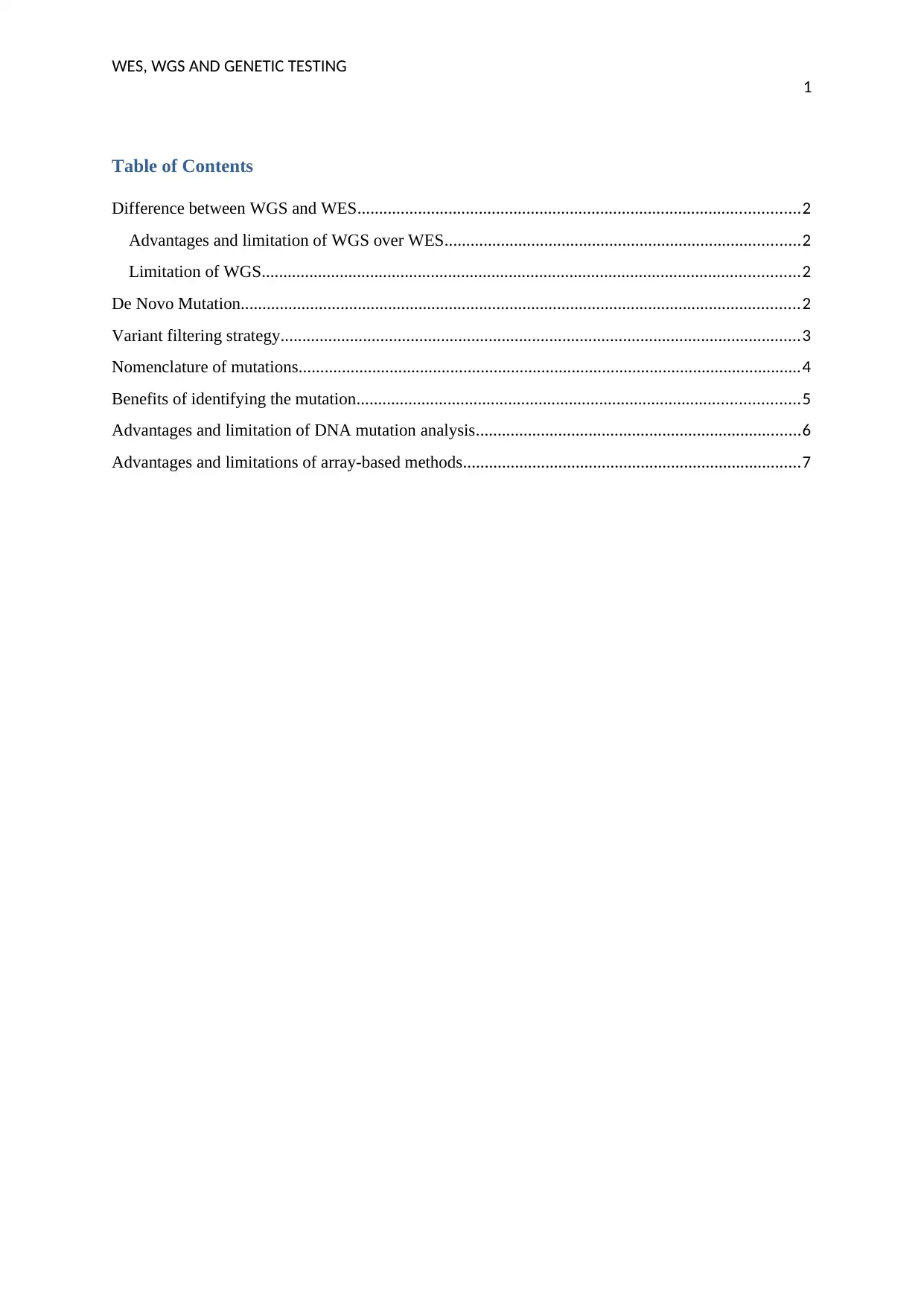
WES, WGS AND GENETIC TESTING
1
Table of Contents
Difference between WGS and WES......................................................................................................2
Advantages and limitation of WGS over WES..................................................................................2
Limitation of WGS............................................................................................................................2
De Novo Mutation.................................................................................................................................2
Variant filtering strategy........................................................................................................................3
Nomenclature of mutations....................................................................................................................4
Benefits of identifying the mutation......................................................................................................5
Advantages and limitation of DNA mutation analysis...........................................................................6
Advantages and limitations of array-based methods..............................................................................7
1
Table of Contents
Difference between WGS and WES......................................................................................................2
Advantages and limitation of WGS over WES..................................................................................2
Limitation of WGS............................................................................................................................2
De Novo Mutation.................................................................................................................................2
Variant filtering strategy........................................................................................................................3
Nomenclature of mutations....................................................................................................................4
Benefits of identifying the mutation......................................................................................................5
Advantages and limitation of DNA mutation analysis...........................................................................6
Advantages and limitations of array-based methods..............................................................................7
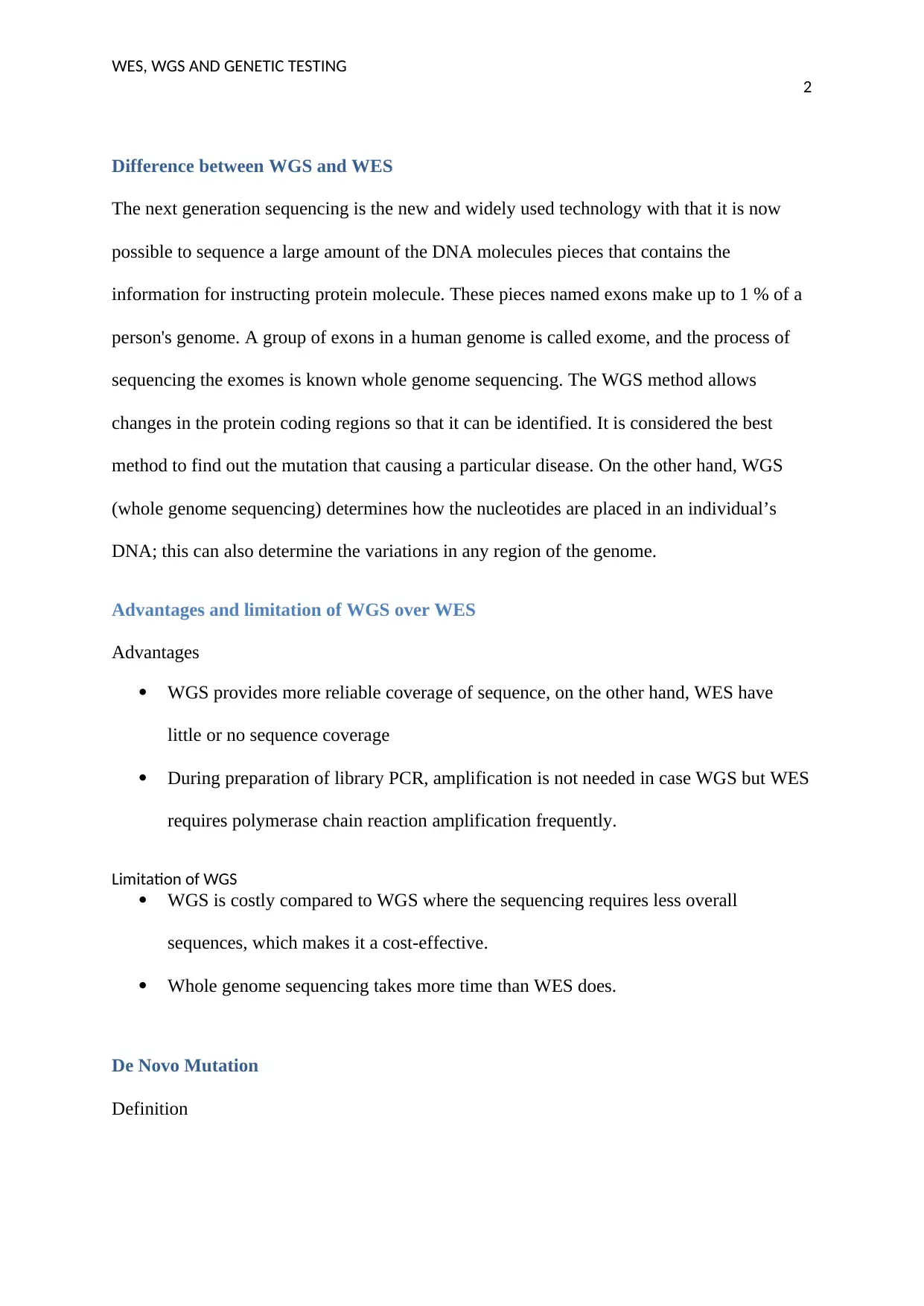
WES, WGS AND GENETIC TESTING
2
Difference between WGS and WES
The next generation sequencing is the new and widely used technology with that it is now
possible to sequence a large amount of the DNA molecules pieces that contains the
information for instructing protein molecule. These pieces named exons make up to 1 % of a
person's genome. A group of exons in a human genome is called exome, and the process of
sequencing the exomes is known whole genome sequencing. The WGS method allows
changes in the protein coding regions so that it can be identified. It is considered the best
method to find out the mutation that causing a particular disease. On the other hand, WGS
(whole genome sequencing) determines how the nucleotides are placed in an individual’s
DNA; this can also determine the variations in any region of the genome.
Advantages and limitation of WGS over WES
Advantages
WGS provides more reliable coverage of sequence, on the other hand, WES have
little or no sequence coverage
During preparation of library PCR, amplification is not needed in case WGS but WES
requires polymerase chain reaction amplification frequently.
Limitation of WGS
WGS is costly compared to WGS where the sequencing requires less overall
sequences, which makes it a cost-effective.
Whole genome sequencing takes more time than WES does.
De Novo Mutation
Definition
2
Difference between WGS and WES
The next generation sequencing is the new and widely used technology with that it is now
possible to sequence a large amount of the DNA molecules pieces that contains the
information for instructing protein molecule. These pieces named exons make up to 1 % of a
person's genome. A group of exons in a human genome is called exome, and the process of
sequencing the exomes is known whole genome sequencing. The WGS method allows
changes in the protein coding regions so that it can be identified. It is considered the best
method to find out the mutation that causing a particular disease. On the other hand, WGS
(whole genome sequencing) determines how the nucleotides are placed in an individual’s
DNA; this can also determine the variations in any region of the genome.
Advantages and limitation of WGS over WES
Advantages
WGS provides more reliable coverage of sequence, on the other hand, WES have
little or no sequence coverage
During preparation of library PCR, amplification is not needed in case WGS but WES
requires polymerase chain reaction amplification frequently.
Limitation of WGS
WGS is costly compared to WGS where the sequencing requires less overall
sequences, which makes it a cost-effective.
Whole genome sequencing takes more time than WES does.
De Novo Mutation
Definition
⊘ This is a preview!⊘
Do you want full access?
Subscribe today to unlock all pages.

Trusted by 1+ million students worldwide
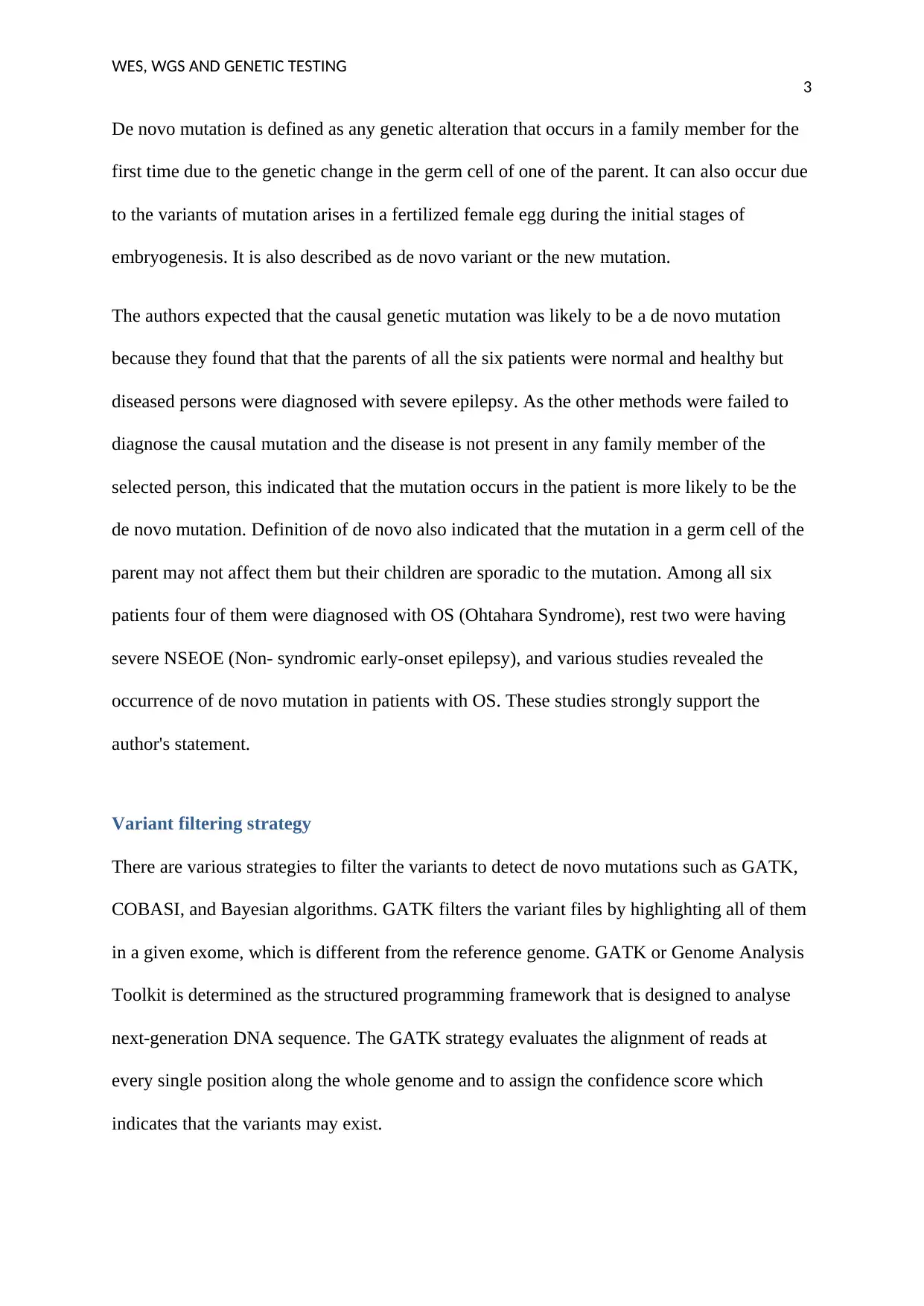
WES, WGS AND GENETIC TESTING
3
De novo mutation is defined as any genetic alteration that occurs in a family member for the
first time due to the genetic change in the germ cell of one of the parent. It can also occur due
to the variants of mutation arises in a fertilized female egg during the initial stages of
embryogenesis. It is also described as de novo variant or the new mutation.
The authors expected that the causal genetic mutation was likely to be a de novo mutation
because they found that that the parents of all the six patients were normal and healthy but
diseased persons were diagnosed with severe epilepsy. As the other methods were failed to
diagnose the causal mutation and the disease is not present in any family member of the
selected person, this indicated that the mutation occurs in the patient is more likely to be the
de novo mutation. Definition of de novo also indicated that the mutation in a germ cell of the
parent may not affect them but their children are sporadic to the mutation. Among all six
patients four of them were diagnosed with OS (Ohtahara Syndrome), rest two were having
severe NSEOE (Non- syndromic early-onset epilepsy), and various studies revealed the
occurrence of de novo mutation in patients with OS. These studies strongly support the
author's statement.
Variant filtering strategy
There are various strategies to filter the variants to detect de novo mutations such as GATK,
COBASI, and Bayesian algorithms. GATK filters the variant files by highlighting all of them
in a given exome, which is different from the reference genome. GATK or Genome Analysis
Toolkit is determined as the structured programming framework that is designed to analyse
next-generation DNA sequence. The GATK strategy evaluates the alignment of reads at
every single position along the whole genome and to assign the confidence score which
indicates that the variants may exist.
3
De novo mutation is defined as any genetic alteration that occurs in a family member for the
first time due to the genetic change in the germ cell of one of the parent. It can also occur due
to the variants of mutation arises in a fertilized female egg during the initial stages of
embryogenesis. It is also described as de novo variant or the new mutation.
The authors expected that the causal genetic mutation was likely to be a de novo mutation
because they found that that the parents of all the six patients were normal and healthy but
diseased persons were diagnosed with severe epilepsy. As the other methods were failed to
diagnose the causal mutation and the disease is not present in any family member of the
selected person, this indicated that the mutation occurs in the patient is more likely to be the
de novo mutation. Definition of de novo also indicated that the mutation in a germ cell of the
parent may not affect them but their children are sporadic to the mutation. Among all six
patients four of them were diagnosed with OS (Ohtahara Syndrome), rest two were having
severe NSEOE (Non- syndromic early-onset epilepsy), and various studies revealed the
occurrence of de novo mutation in patients with OS. These studies strongly support the
author's statement.
Variant filtering strategy
There are various strategies to filter the variants to detect de novo mutations such as GATK,
COBASI, and Bayesian algorithms. GATK filters the variant files by highlighting all of them
in a given exome, which is different from the reference genome. GATK or Genome Analysis
Toolkit is determined as the structured programming framework that is designed to analyse
next-generation DNA sequence. The GATK strategy evaluates the alignment of reads at
every single position along the whole genome and to assign the confidence score which
indicates that the variants may exist.
Paraphrase This Document
Need a fresh take? Get an instant paraphrase of this document with our AI Paraphraser
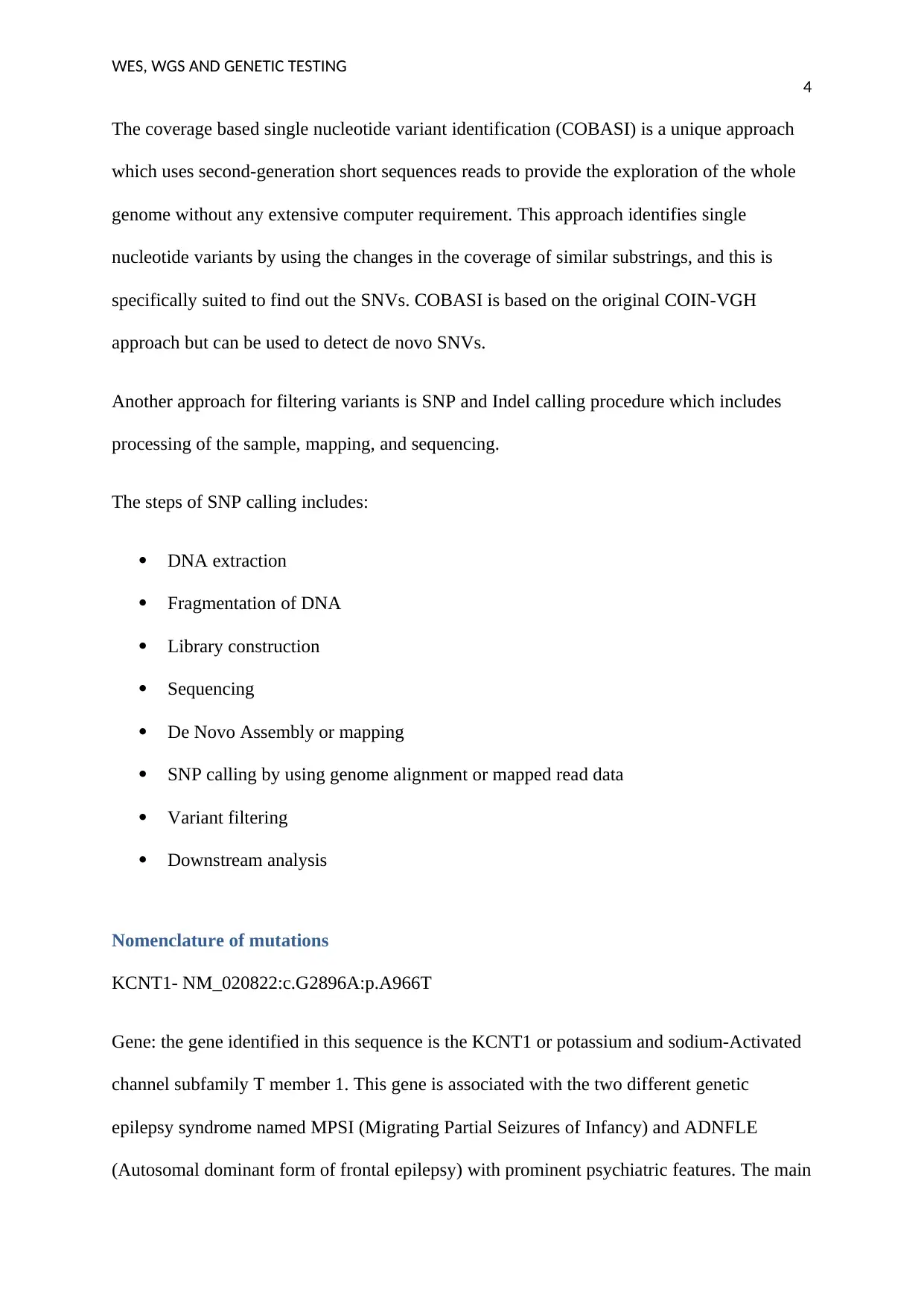
WES, WGS AND GENETIC TESTING
4
The coverage based single nucleotide variant identification (COBASI) is a unique approach
which uses second-generation short sequences reads to provide the exploration of the whole
genome without any extensive computer requirement. This approach identifies single
nucleotide variants by using the changes in the coverage of similar substrings, and this is
specifically suited to find out the SNVs. COBASI is based on the original COIN-VGH
approach but can be used to detect de novo SNVs.
Another approach for filtering variants is SNP and Indel calling procedure which includes
processing of the sample, mapping, and sequencing.
The steps of SNP calling includes:
DNA extraction
Fragmentation of DNA
Library construction
Sequencing
De Novo Assembly or mapping
SNP calling by using genome alignment or mapped read data
Variant filtering
Downstream analysis
Nomenclature of mutations
KCNT1- NM_020822:c.G2896A:p.A966T
Gene: the gene identified in this sequence is the KCNT1 or potassium and sodium-Activated
channel subfamily T member 1. This gene is associated with the two different genetic
epilepsy syndrome named MPSI (Migrating Partial Seizures of Infancy) and ADNFLE
(Autosomal dominant form of frontal epilepsy) with prominent psychiatric features. The main
4
The coverage based single nucleotide variant identification (COBASI) is a unique approach
which uses second-generation short sequences reads to provide the exploration of the whole
genome without any extensive computer requirement. This approach identifies single
nucleotide variants by using the changes in the coverage of similar substrings, and this is
specifically suited to find out the SNVs. COBASI is based on the original COIN-VGH
approach but can be used to detect de novo SNVs.
Another approach for filtering variants is SNP and Indel calling procedure which includes
processing of the sample, mapping, and sequencing.
The steps of SNP calling includes:
DNA extraction
Fragmentation of DNA
Library construction
Sequencing
De Novo Assembly or mapping
SNP calling by using genome alignment or mapped read data
Variant filtering
Downstream analysis
Nomenclature of mutations
KCNT1- NM_020822:c.G2896A:p.A966T
Gene: the gene identified in this sequence is the KCNT1 or potassium and sodium-Activated
channel subfamily T member 1. This gene is associated with the two different genetic
epilepsy syndrome named MPSI (Migrating Partial Seizures of Infancy) and ADNFLE
(Autosomal dominant form of frontal epilepsy) with prominent psychiatric features. The main
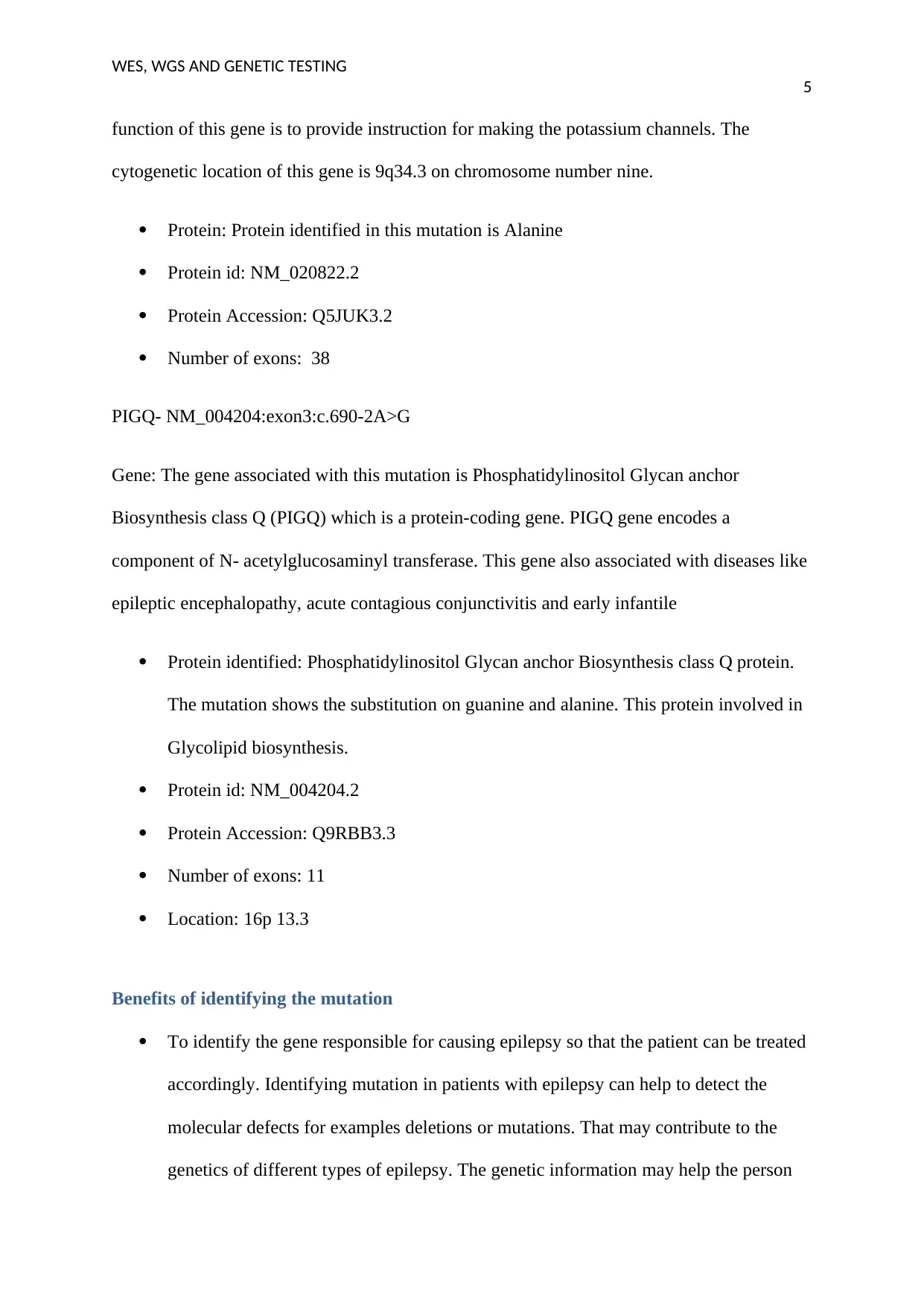
WES, WGS AND GENETIC TESTING
5
function of this gene is to provide instruction for making the potassium channels. The
cytogenetic location of this gene is 9q34.3 on chromosome number nine.
Protein: Protein identified in this mutation is Alanine
Protein id: NM_020822.2
Protein Accession: Q5JUK3.2
Number of exons: 38
PIGQ- NM_004204:exon3:c.690-2A>G
Gene: The gene associated with this mutation is Phosphatidylinositol Glycan anchor
Biosynthesis class Q (PIGQ) which is a protein-coding gene. PIGQ gene encodes a
component of N- acetylglucosaminyl transferase. This gene also associated with diseases like
epileptic encephalopathy, acute contagious conjunctivitis and early infantile
Protein identified: Phosphatidylinositol Glycan anchor Biosynthesis class Q protein.
The mutation shows the substitution on guanine and alanine. This protein involved in
Glycolipid biosynthesis.
Protein id: NM_004204.2
Protein Accession: Q9RBB3.3
Number of exons: 11
Location: 16p 13.3
Benefits of identifying the mutation
To identify the gene responsible for causing epilepsy so that the patient can be treated
accordingly. Identifying mutation in patients with epilepsy can help to detect the
molecular defects for examples deletions or mutations. That may contribute to the
genetics of different types of epilepsy. The genetic information may help the person
5
function of this gene is to provide instruction for making the potassium channels. The
cytogenetic location of this gene is 9q34.3 on chromosome number nine.
Protein: Protein identified in this mutation is Alanine
Protein id: NM_020822.2
Protein Accession: Q5JUK3.2
Number of exons: 38
PIGQ- NM_004204:exon3:c.690-2A>G
Gene: The gene associated with this mutation is Phosphatidylinositol Glycan anchor
Biosynthesis class Q (PIGQ) which is a protein-coding gene. PIGQ gene encodes a
component of N- acetylglucosaminyl transferase. This gene also associated with diseases like
epileptic encephalopathy, acute contagious conjunctivitis and early infantile
Protein identified: Phosphatidylinositol Glycan anchor Biosynthesis class Q protein.
The mutation shows the substitution on guanine and alanine. This protein involved in
Glycolipid biosynthesis.
Protein id: NM_004204.2
Protein Accession: Q9RBB3.3
Number of exons: 11
Location: 16p 13.3
Benefits of identifying the mutation
To identify the gene responsible for causing epilepsy so that the patient can be treated
accordingly. Identifying mutation in patients with epilepsy can help to detect the
molecular defects for examples deletions or mutations. That may contribute to the
genetics of different types of epilepsy. The genetic information may help the person
⊘ This is a preview!⊘
Do you want full access?
Subscribe today to unlock all pages.

Trusted by 1+ million students worldwide
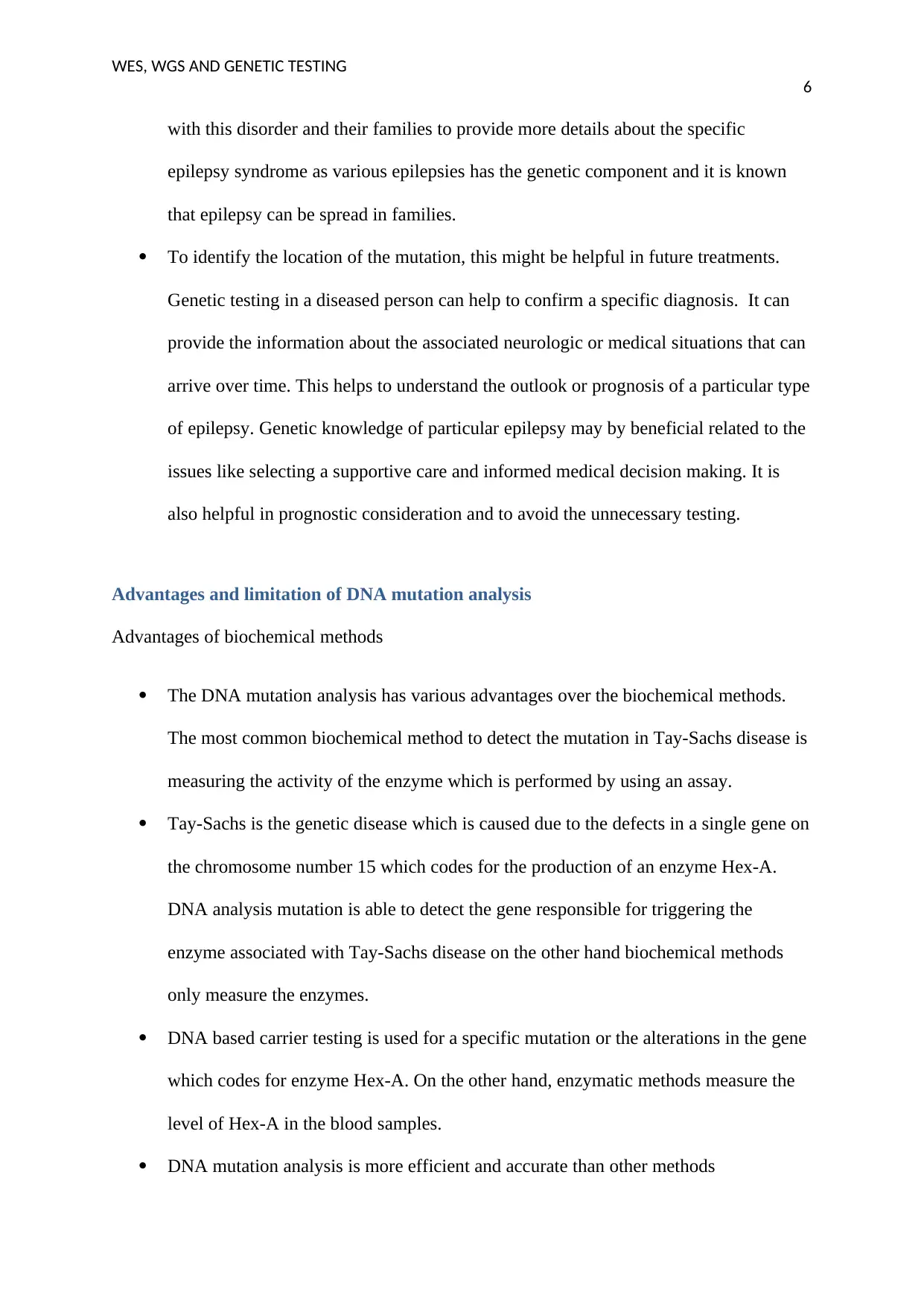
WES, WGS AND GENETIC TESTING
6
with this disorder and their families to provide more details about the specific
epilepsy syndrome as various epilepsies has the genetic component and it is known
that epilepsy can be spread in families.
To identify the location of the mutation, this might be helpful in future treatments.
Genetic testing in a diseased person can help to confirm a specific diagnosis. It can
provide the information about the associated neurologic or medical situations that can
arrive over time. This helps to understand the outlook or prognosis of a particular type
of epilepsy. Genetic knowledge of particular epilepsy may by beneficial related to the
issues like selecting a supportive care and informed medical decision making. It is
also helpful in prognostic consideration and to avoid the unnecessary testing.
Advantages and limitation of DNA mutation analysis
Advantages of biochemical methods
The DNA mutation analysis has various advantages over the biochemical methods.
The most common biochemical method to detect the mutation in Tay-Sachs disease is
measuring the activity of the enzyme which is performed by using an assay.
Tay-Sachs is the genetic disease which is caused due to the defects in a single gene on
the chromosome number 15 which codes for the production of an enzyme Hex-A.
DNA analysis mutation is able to detect the gene responsible for triggering the
enzyme associated with Tay-Sachs disease on the other hand biochemical methods
only measure the enzymes.
DNA based carrier testing is used for a specific mutation or the alterations in the gene
which codes for enzyme Hex-A. On the other hand, enzymatic methods measure the
level of Hex-A in the blood samples.
DNA mutation analysis is more efficient and accurate than other methods
6
with this disorder and their families to provide more details about the specific
epilepsy syndrome as various epilepsies has the genetic component and it is known
that epilepsy can be spread in families.
To identify the location of the mutation, this might be helpful in future treatments.
Genetic testing in a diseased person can help to confirm a specific diagnosis. It can
provide the information about the associated neurologic or medical situations that can
arrive over time. This helps to understand the outlook or prognosis of a particular type
of epilepsy. Genetic knowledge of particular epilepsy may by beneficial related to the
issues like selecting a supportive care and informed medical decision making. It is
also helpful in prognostic consideration and to avoid the unnecessary testing.
Advantages and limitation of DNA mutation analysis
Advantages of biochemical methods
The DNA mutation analysis has various advantages over the biochemical methods.
The most common biochemical method to detect the mutation in Tay-Sachs disease is
measuring the activity of the enzyme which is performed by using an assay.
Tay-Sachs is the genetic disease which is caused due to the defects in a single gene on
the chromosome number 15 which codes for the production of an enzyme Hex-A.
DNA analysis mutation is able to detect the gene responsible for triggering the
enzyme associated with Tay-Sachs disease on the other hand biochemical methods
only measure the enzymes.
DNA based carrier testing is used for a specific mutation or the alterations in the gene
which codes for enzyme Hex-A. On the other hand, enzymatic methods measure the
level of Hex-A in the blood samples.
DNA mutation analysis is more efficient and accurate than other methods
Paraphrase This Document
Need a fresh take? Get an instant paraphrase of this document with our AI Paraphraser
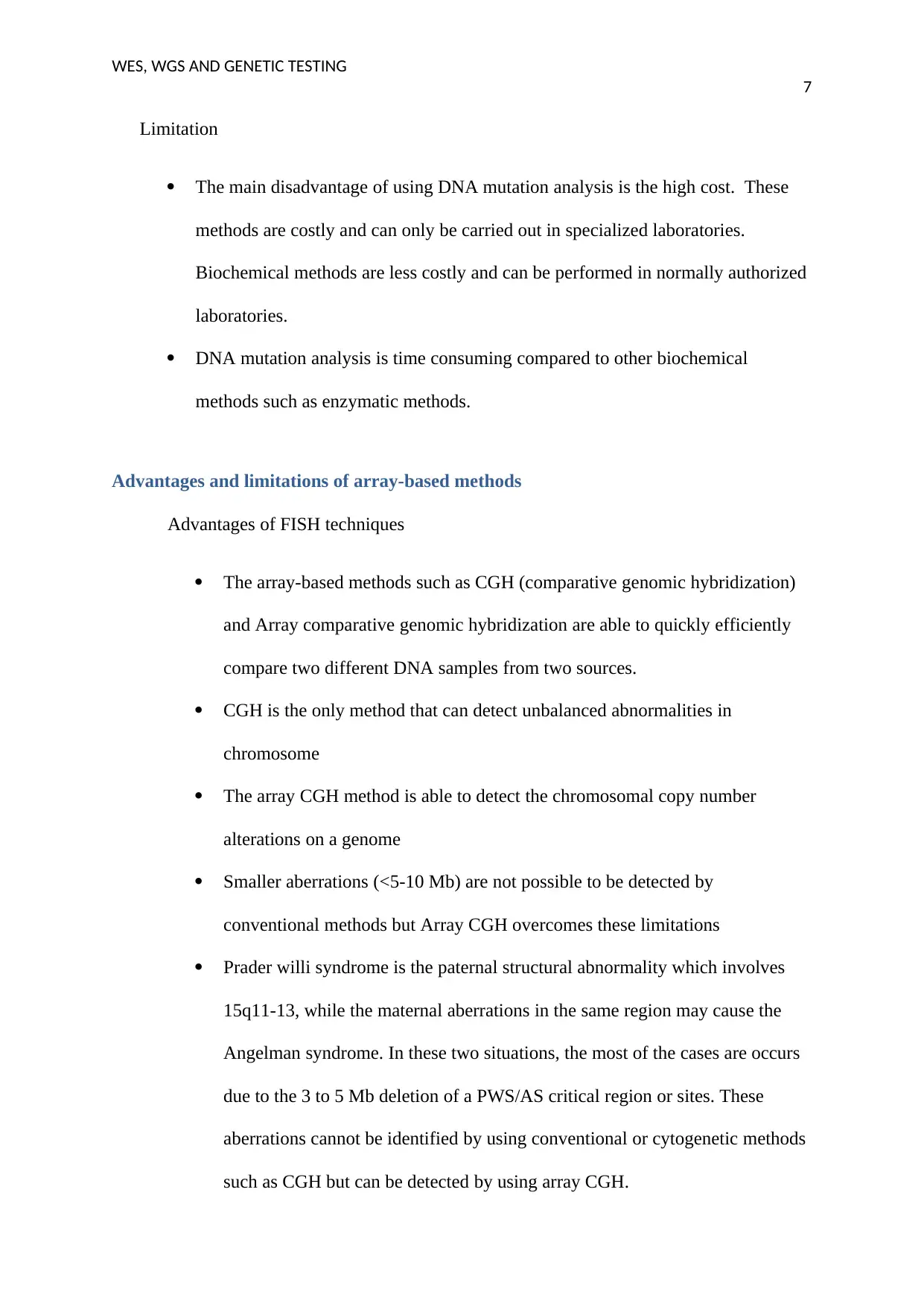
WES, WGS AND GENETIC TESTING
7
Limitation
The main disadvantage of using DNA mutation analysis is the high cost. These
methods are costly and can only be carried out in specialized laboratories.
Biochemical methods are less costly and can be performed in normally authorized
laboratories.
DNA mutation analysis is time consuming compared to other biochemical
methods such as enzymatic methods.
Advantages and limitations of array-based methods
Advantages of FISH techniques
The array-based methods such as CGH (comparative genomic hybridization)
and Array comparative genomic hybridization are able to quickly efficiently
compare two different DNA samples from two sources.
CGH is the only method that can detect unbalanced abnormalities in
chromosome
The array CGH method is able to detect the chromosomal copy number
alterations on a genome
Smaller aberrations (<5-10 Mb) are not possible to be detected by
conventional methods but Array CGH overcomes these limitations
Prader willi syndrome is the paternal structural abnormality which involves
15q11-13, while the maternal aberrations in the same region may cause the
Angelman syndrome. In these two situations, the most of the cases are occurs
due to the 3 to 5 Mb deletion of a PWS/AS critical region or sites. These
aberrations cannot be identified by using conventional or cytogenetic methods
such as CGH but can be detected by using array CGH.
7
Limitation
The main disadvantage of using DNA mutation analysis is the high cost. These
methods are costly and can only be carried out in specialized laboratories.
Biochemical methods are less costly and can be performed in normally authorized
laboratories.
DNA mutation analysis is time consuming compared to other biochemical
methods such as enzymatic methods.
Advantages and limitations of array-based methods
Advantages of FISH techniques
The array-based methods such as CGH (comparative genomic hybridization)
and Array comparative genomic hybridization are able to quickly efficiently
compare two different DNA samples from two sources.
CGH is the only method that can detect unbalanced abnormalities in
chromosome
The array CGH method is able to detect the chromosomal copy number
alterations on a genome
Smaller aberrations (<5-10 Mb) are not possible to be detected by
conventional methods but Array CGH overcomes these limitations
Prader willi syndrome is the paternal structural abnormality which involves
15q11-13, while the maternal aberrations in the same region may cause the
Angelman syndrome. In these two situations, the most of the cases are occurs
due to the 3 to 5 Mb deletion of a PWS/AS critical region or sites. These
aberrations cannot be identified by using conventional or cytogenetic methods
such as CGH but can be detected by using array CGH.

WES, WGS AND GENETIC TESTING
8
It can be used to detect genetic abnormalities in cancer.
It is also used for analyzing DNA copy number abnormality or aberration that
may cause the genetic disorder.
Limitations
It is unable to detect the structural chromosomal aberrations
Unable to detect the aberrations that do not leads to the copy number changes
8
It can be used to detect genetic abnormalities in cancer.
It is also used for analyzing DNA copy number abnormality or aberration that
may cause the genetic disorder.
Limitations
It is unable to detect the structural chromosomal aberrations
Unable to detect the aberrations that do not leads to the copy number changes
⊘ This is a preview!⊘
Do you want full access?
Subscribe today to unlock all pages.

Trusted by 1+ million students worldwide
1 out of 9
Your All-in-One AI-Powered Toolkit for Academic Success.
+13062052269
info@desklib.com
Available 24*7 on WhatsApp / Email
![[object Object]](/_next/static/media/star-bottom.7253800d.svg)
Unlock your academic potential
Copyright © 2020–2025 A2Z Services. All Rights Reserved. Developed and managed by ZUCOL.